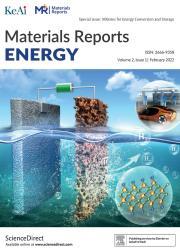Asymmetric ruthenium-iron dipole enabling fast alkaline water splitting on ruthenium-doped iron-nickel layered double hydroxides
IF 13.8
引用次数: 0
Abstract
Electrically driven water splitting is an efficient method for green hydrogen production; however, its practical application is substantially constrained by the kinetically sluggish anodic oxygen evolution reaction (OER). Ruthenium (Ru) and its oxides are widely recognized as highly active OER catalysts. Although Ru is significantly cheaper than iridium (Ir), further reducing its content remains desirable. Herein, atomically dispersed Ru is doped into iron-nickel layered double hydroxides (Ru-FeNi-LDH) to decrease the Ru usage. We found that the Ru doping limit is roughly 9 wt%, and the Ru doping content significantly alters the OER kinetics—note that the high Ru concentration remarkably damages the Ru-FeNi-LDH structure and leads to agglomeration formation. By optimizing the Ru doping content to 3.3 wt%, the Ru-FeNi-LDH presents a low overpotential of 230 mV to reach a current density of 10 mA cm−2 in 1 M KOH, which is far better than the reference FeNi-LDH (280 mV) and RuO2 (350 mV). In the overall water splitting test, the current density of 10 mA cm−2 can be reached at a low voltage of 1.52 V, with stable operation for 80 h. Interestingly, Ru and Fe form an asymmetric Ru-Fe dipole, which is likely doped together into the LDH because the content of Fe instead of Ni is dependent on Ru content in experimental results. The electron-deficient feature of the Ru-Fe dipole thus facilitates the OER process. This work demonstrates a dual-transition metal synergy, providing a design strategy for OER and related catalysts.

不对称钌-铁偶极子使碱水在钌掺杂铁-镍层状双氢氧化物上快速分解
电驱动水裂解是一种高效的绿色制氢方法;然而,它的实际应用受到动力学缓慢的阳极析氧反应(OER)的很大限制。钌(Ru)及其氧化物是公认的高活性OER催化剂。虽然钌比铱(Ir)便宜得多,但进一步降低其含量仍然是可取的。在这里,原子分散的Ru被掺杂到铁镍层状双氢氧化物(Ru- feni - ldh)中,以减少Ru的使用。我们发现Ru的掺杂极限约为9 wt%,并且Ru的掺杂含量显著改变了OER动力学,注意高浓度的Ru显著破坏了Ru- feni - ldh结构并导致团聚形成。通过将Ru掺杂量优化到3.3 wt%, Ru-FeNi-LDH在1 M KOH下的过电位为230 mV,电流密度为10 mA cm−2,远优于参考FeNi-LDH (280 mV)和RuO2 (350 mV)。在整体水分解测试中,在1.52 V的低电压下,电流密度可达到10 mA cm−2,稳定运行80 h。有趣的是,Ru和Fe形成了不对称的Ru-Fe偶极子,很可能是一起掺杂到LDH中,因为实验结果中依赖于Ru含量的是Fe而不是Ni。因此,Ru-Fe偶极子的缺电子特性促进了OER过程。这项工作证明了双过渡金属协同作用,为OER和相关催化剂的设计提供了一种策略。
本文章由计算机程序翻译,如有差异,请以英文原文为准。
求助全文
约1分钟内获得全文
求助全文
来源期刊

材料导报:能源(英文)
Renewable Energy, Sustainability and the Environment, Nanotechnology
CiteScore
13.00
自引率
0.00%
发文量
0
审稿时长
50 days
 求助内容:
求助内容: 应助结果提醒方式:
应助结果提醒方式:


